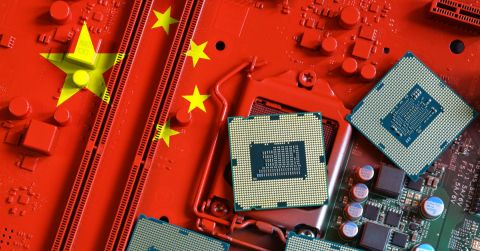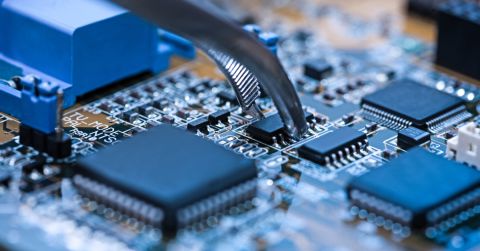Aerospace and Defense: An Unexpected Investor in Microelectronics

The aerospace and defense industries have experienced an unprecedented surge in advancement, largely driven by the rapid growth of the commercial space industry and the increasing sophistication of defense-ready microelectronics. From satellite components to AI-enabled systems for next-generation aircraft, the marriage of aerospace ambition and microelectronic innovation is reshaping our approach to the final frontier and national security.
Let's examine how recent developments are transforming these industries, attracting new investors, and spurring related economic growth.
The Rise of Commercial Space and Its Impact on Microelectronics
The rapid growth of the commercial space industry, led by companies like SpaceX, Blue Origin, and Rocket Lab, has significantly impacted the aerospace microelectronics sector. This boom has driven demand for more cost-effective, reliable, and radiation-hardened components suitable for use in space environments.
Other driving forces leading the market include cost reduction and miniaturization. In cost reduction, commercial space companies are pushing for more affordable solutions, leading to the development of radiation-tolerant components that offer a middle ground between commercial and fully radiation-hardened parts. This approach helps balance performance and cost for various space missions. And the trend towards smaller satellites and constellations has pushed for miniaturization and increased functionality of microelectronic systems.
Microelectronics Development and Advancement
Miniaturized sensors and actuators are essential for capturing analog signals, monitoring environmental conditions and controlling assorted systems onboard aircraft and spacecraft. Today's aerospace and defense engineers can design sensors that are smaller, lighter and more energy efficient.
Hardware advancements are also making an impact as aerospace and defense companies leverage microelectronics to enhance cybersecurity and data protection. With the increasing connectivity of modern aircraft and defense systems, cybersecurity has become a priority. Microelectronics plays a big role in implementing encryption, authentication, and intrusion detection mechanisms to safeguard sensitive information from the increasing sophistication of cyber threats.
In addition, the following fields are influencing further advancements in microelectronics:
- Quantum Computing: The aerospace and defense sector is increasingly investing in quantum computing technologies that promise to revolutionize cryptography, optimization problems, and simulation capabilities, potentially transforming areas such as secure communications and complex system modeling.
- AI and Machine Learning Integration: Recent efforts have focused on integrating more sophisticated AI and machine learning algorithms into aerospace and defense systems. This integration enhances autonomous decision-making capabilities in unmanned systems and improves predictive maintenance for aircraft and spacecraft.
- Hypersonic Technology: The development of hypersonic vehicles and weapons has accelerated, driving innovation in microelectronics that can withstand extreme temperatures and pressures. This includes the creation of advanced sensors and guidance systems capable of operating in hypersonic conditions.
- 5G and 6G Communications: The aerospace and defense industry is leveraging 5G technology and preparing for 6G, which will enable faster, more secure, and more reliable communications. This advancement is crucial for improving situational awareness, enhancing command and control systems, and enabling new capabilities in networked warfare.
- Drones and Drone Swarms: Following the pursuit of air superiority, militaries all over the world are focused on developing fully autonomous drone systems, including drone models with swarm or wingman capabilities. Related areas of investment include loitering munitions, drone EW countermeasures, and robotics in general.

The integration of microelectronics into aerospace and defense systems also has its challenges. Harsh operating environments include extreme temperatures, radiation,n and vibration, and this ushers in significant reliability and durability concerns. Increasing complexity and system interdependence also bring new risks and vulnerabilities, all requiring rigorous testing and validation processes.
Supply Chain Risks
Supply chain risks are also a major concern in the aerospace and defense sector, especially concerning the integration of microelectronics into their systems. Here are some specific areas of concern regarding supply chain risks in this context:
- Supply Chain Disruptions and Resilience: Disruptions in the supply chain – such as natural disasters, cyber-attacks, and transportation bottlenecks – can have far-reaching consequences. Robust supply chain resilience strategies, including diversifying suppliers, maintaining buffer stocks of critical components, and implementing contingency plans, are essential to managing disruptions.
- Intellectual Property Protection: Protecting sensitive information and proprietary designs throughout the supply chain is critical to safeguard against counterfeiting, theft, and unauthorized replication. Lack of adequate intellectual property protection can undermine innovation and competitiveness.
- Quality Control and Reliability: The quality and reliability of components throughout the supply chain need to remain consistent to prevent system failures or malfunctions in mission-critical operations. Counterfeit parts, substandard manufacturing processes, or inadequate testing procedures create larger risks to the integrity and performance of aerospace and defense systems.
- Regulatory Compliance and Export Controls: Compliance with export control laws, such as the International Traffic in Arms Regulations (ITAR) in the United States, is essential to prevent the unauthorized transfer of sensitive technologies or components to restricted parties or countries. Failure to comply with regulatory requirements can result in legal penalties, reputational damage, and restrictions on market access.
- Cybersecurity and Data Protection: Cybersecurity risks are a growing threat to the supply chain. Vulnerabilities in software, communication networks, and embedded systems can be exploited to compromise the confidentiality, integrity, or availability of critical information or operations. Protecting against cyber threats requires strong cybersecurity measures, including encryption, authentication, intrusion detection, and incident response capabilities.
Additive Manufacturing in Microelectronics Production
The adoption of additive manufacturing (3D printing) techniques in the production of microelectronics for aerospace and defense applications has gained momentum. This technology allows for the creation of complex geometries and integrated structures that were previously impossible or impractical to manufacture.
DARPA's new Additive Manufacturing of Microelectronic systEms (AMME) program represents a significant advancement in this space, aiming to revolutionize microsystems production through multi-material manufacturing capabilities. The program focuses on achieving breakthroughs in material quality, high resolution, and massive print throughput, enabling the creation of microsystems with innovative geometries that can integrate mechanical, electrical, or biological components. This initiative comes as additive manufacturing increasingly establishes itself in regulated industries, particularly in semiconductor equipment manufacturing, where it's being used for advanced thermal management through customized heat sinks and channels.
The global market for Aerospace Additive Manufacturing is estimated at US$1.2 Billion for 2023 and is projected to reach US$3.8 Billion by 2030, growing at a CAGR of 18.3% from 2023 to 2030. Additive manufacturing has opened new possibilities for designing more efficient and lightweight components, potentially revolutionizing aspects of aircraft and spacecraft design.
For more on current aerospace design trends, see 6 Electronic Trends Shaping Aerospace Design.
Economic Issues
The intersection of aerospace and defense with microelectronics brings about several economic issues as well:
- R&D Investment: Investing in microelectronics requires considerable research and development expenditures to innovate and stay ahead in terms of performance, reliability, and miniaturization.
- Cost Management: Miniaturization and increased complexity in microelectronics can drive up manufacturing costs. Aerospace and defense companies must carefully manage these costs to meet financial, contract, and regulatory requirements.
- Market Demand and Volatility: Economic fluctuations and changes in defense budgets can significantly impact the demand for aerospace and defense products, including those incorporating microelectronics. Companies in this sector must navigate market volatility and adjust production levels accordingly.
- Global Competition: The aerospace and defense industries face powerful global competition from traditional rivals and emerging players in regions like Asia. Economic issues such as currency fluctuations, labor costs, and government subsidies can influence the competitiveness of companies in this sector.
As aerospace and defense industries continue to push the boundaries of innovation, microelectronics remain at the heart of it all. From commercial space ventures to advanced defense systems, the symbiotic relationship between these sectors drives continuous advancement in miniaturization, reliability, and performance.
While challenges persist in supply chain security, manufacturing costs, and environmental resilience, new initiatives like DARPA's AMME program and the industry's commitment to sustainable technologies demonstrate a promising path forward. As we look to the future, the aerospace and defense sector's investment in microelectronics will continue to catalyze breakthroughs that benefit not only national security and space exploration but also broader commercial applications and technological progress.









